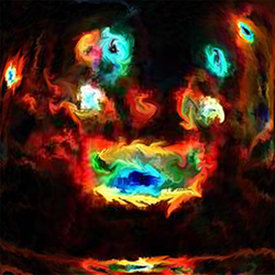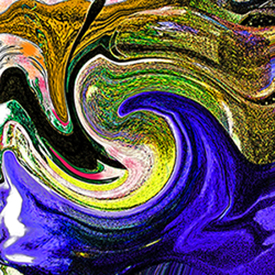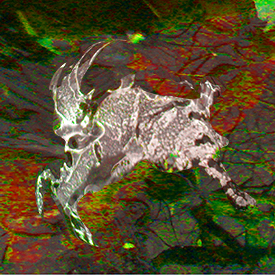
Tao and Taiji
A careful understanding of Nature's rhythms and constantly changing course provides the underlying guidance for harmonious living.
A Perspective on the Origins of Existence
We are alive. The world in which we live exists. Despite all our knowledge and understanding of the workings of life, the mystery of what brings everything we experience in to being remains unknowable. We may have our faith to guide our interpretation, but that requires a leap from experiential knowledge into trusting a particular version of the world's origin.
What existed before existence, before the big bang, and set creation in motion? In Chinese philosophy the concept of everything being one is known as Wuji. But what preexisted Wuji? Before oneness? Before light? Before time? Before the beginning? Before nothing?
Before Existence was Chaos or Formlessness
The first thing to happen therefore was for the formless to come into form. The first act united the formless into form. In unification a singular entity came into existence. This is Oneness is called Wuji. It is timeless. It exists without movement; without mass; without light or dark; without energy, yet holds all potential. For the potential to be realized, change takes place. The instant the oneness of Wuji changes, it becomes Taiji. Oneness splits into two. There is now one and another. Differences materialize. With this first change, the world comes into being.
The Origins of Form and Movement
Taoists philosophy is founded on observing the world, to witness how its constant changes reveal its unchanging essence. Change is the one constant in the universe. And yet at the center of all change is a permanence—something that remains unchanged. That which is changeless cannot be perceived. The amorphousness of an undefined existence is simultaneously one and all. Call it God or call it Tao, or call it by any name you wish and you cannot describe it.
Form, substance, energy, time, and space come into being and as they do things become things, nothing becomes something, and the world emerges. As it does, change becomes the norm. Change or transformation implies form, energy, and movement. Movement implies space and time. These interdependent aspects are the elements Taijiquan endeavors to utilize in their purist form. These five qualities each have a pivot point around which they change. The present is the pivot point for the past and future. Stillness is the pivot for advancing and retreating. Substance is the pivot between coalescing and dissolving. Positive and negative pivot around neutrality. Balance is the pivot point between empty and full. To move, motion requires stillness.
The world of form is a relative world. Without its counterpoint movement cannot happen. Motion can only be measured in relation to stillness. Up can only be defined by down. Light needs darkness in order to exist.
Time is necessary for a discernible universe to exist. Without time, there can be no movement. Without movement, there can be no change. Without changed there can be no existence, no universe, no Tao. Time is an essential factor in creation. At the intersection of past and future is the still point of the present. Even so, since time is ever-moving, the present is constantly changing. It is both still and moving. Within its Yang of movement exists a Yin of Stillness. Without time, there would be no change.
The Notion of Taiji is Binary
Taiji is made of complementary opposites. As these opposites cannot exist without the other. They are partners. One defines the other. Dark can only be known because there is light. Up only exists because there is down. Once separation begins in one aspect, all the other aspects begin to separate.
In Taoist philosophy, one begets two, and two begets three. As time turns into before and after, “present” is introduced. Thus, we now come to the trinity of past, present and future. Space has up and down; a point of reference emerges and so “here” is born. Male divides from female, and lo a child is born.
As much as these differences separate the parts of existence, nothing can pull them apart. This is why the two-dimensional image of this Taiji phenomenon is a circle divided into two whirling halves. Each half contains a small essence of its opposite, for in the natural world nothing exists by and of itself.
Inseparable Qualities
Yin cannot be separated from Yang just as night cannot be separated from day nor dark departed from light. You're right cannot be separated from your left. Both are parts of your body, but you are one integrated whole. In the art of Taijiquan, you must be able to tell the full from the empty, and yet emptiness is not total. Fullness is not absolute. Each quality contains a small portion of its opposite. In this way, they complement one another. This is the way of the creation.
Putting It Back Together
It's not that Taijiquan asks you to return to before the beginning of existence. Rather it teaches you a way of being in your body. It seeks the center place where the division of stillness and action take place. By residing in the center, you can move in any direction at any time. Like water, you do not have to change your nature to deal with obstacles.
The capacity of being in the place of Wuji—the moment before change happens—means you can adapt to the situation as it is. The center is the place of the present. It means you are not reacting by anticipating a future outcome, nor are you bound by habitual patterns from has happened in the past. Taijiquan transforms you by taking you on an evolutionary progression. Rather than being ruled by impulsive reactions that automatically leap from the reptilian brain by transforming you to be able to access your wisdom, intelligence, and skill to respond appropriately to the situation at hand.





